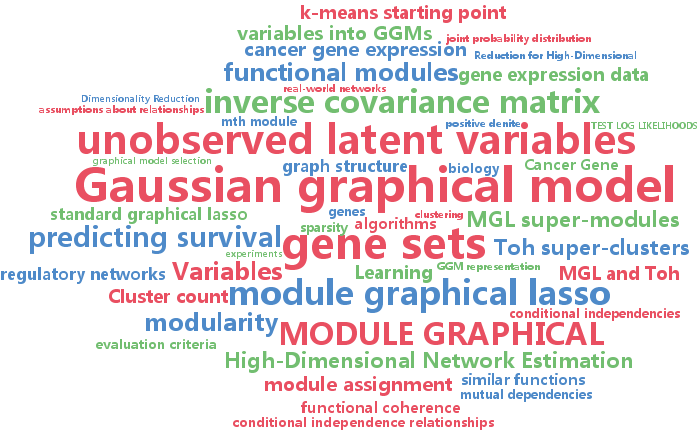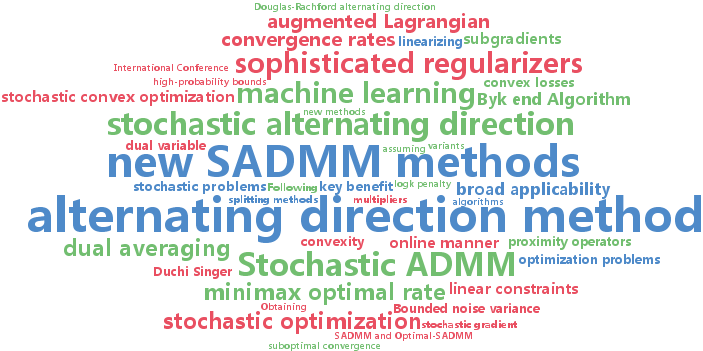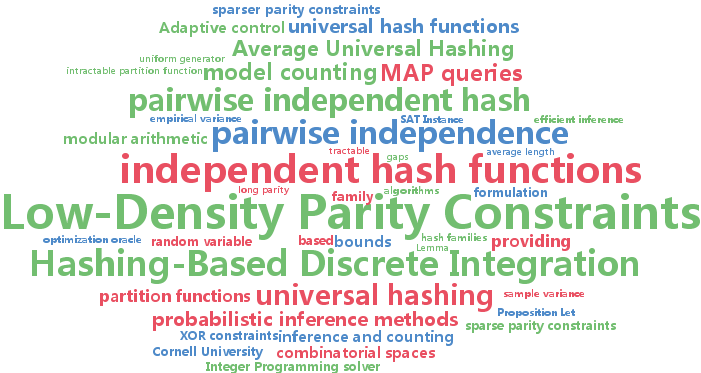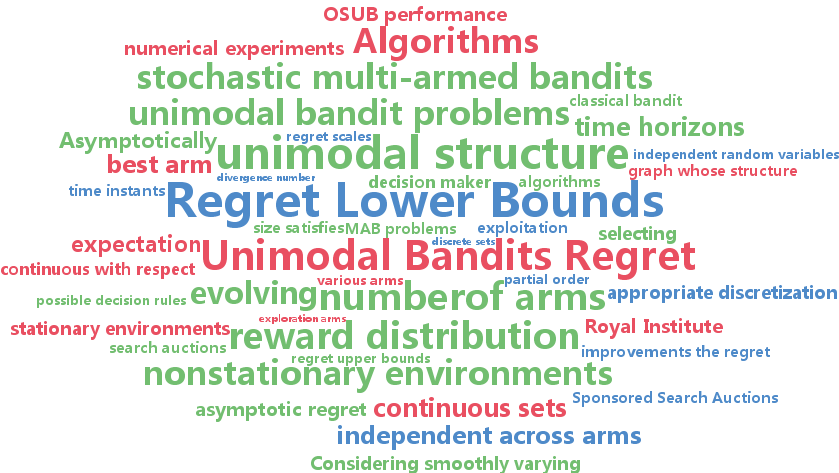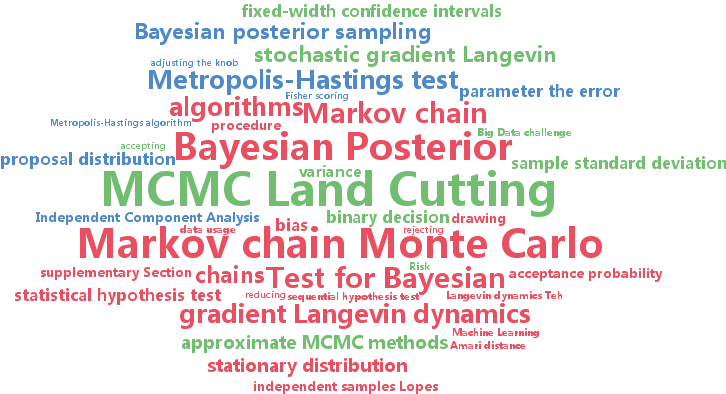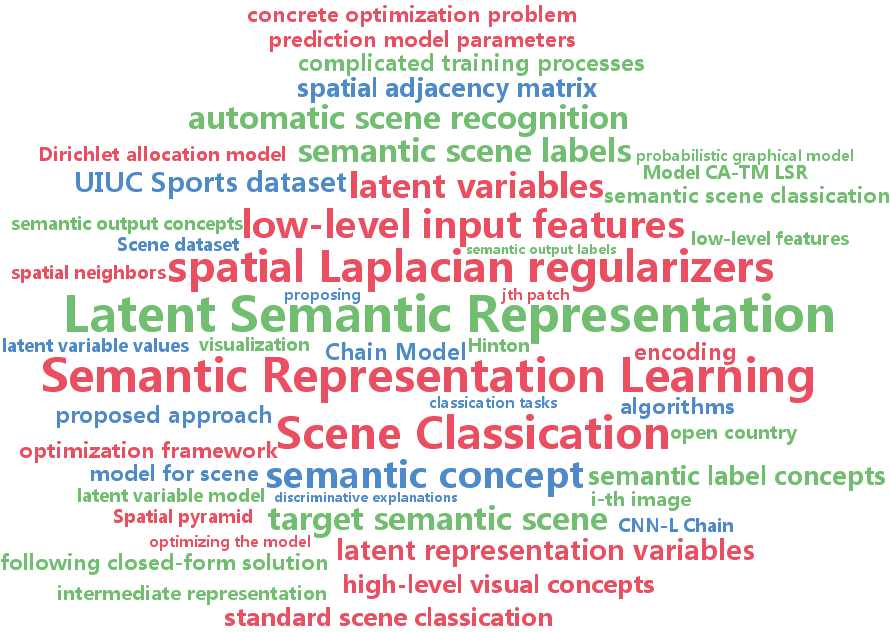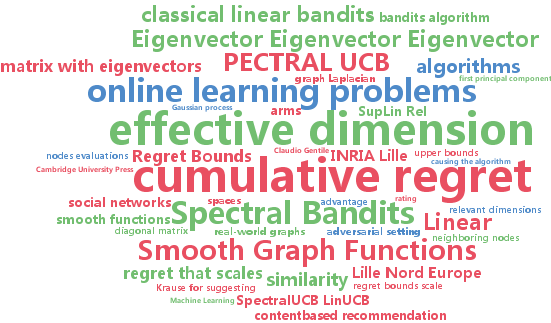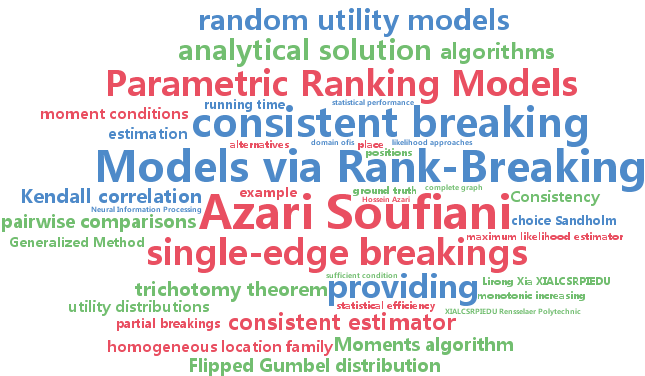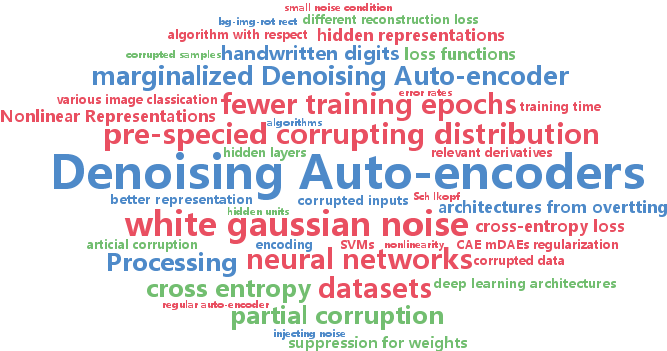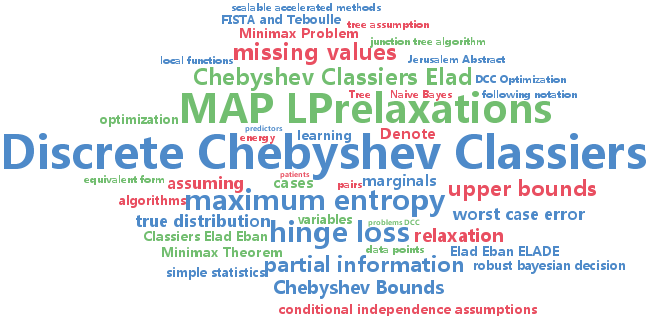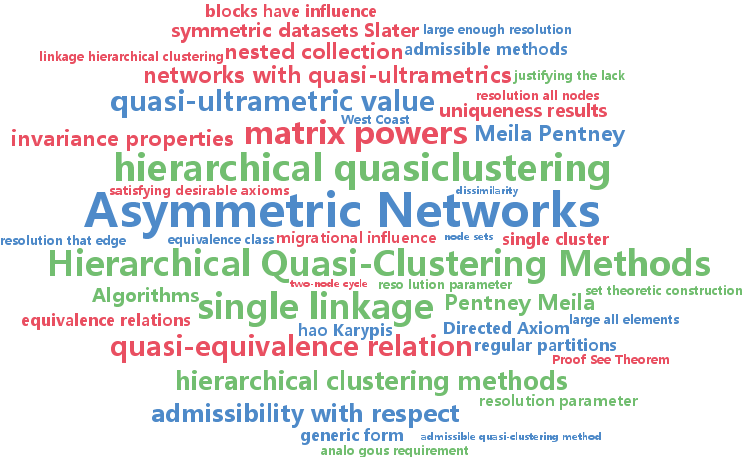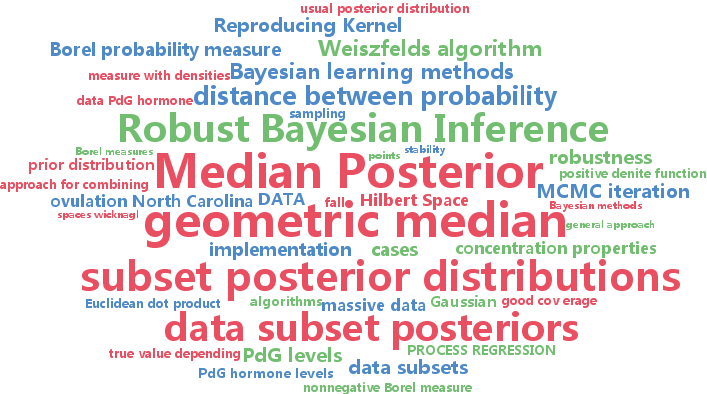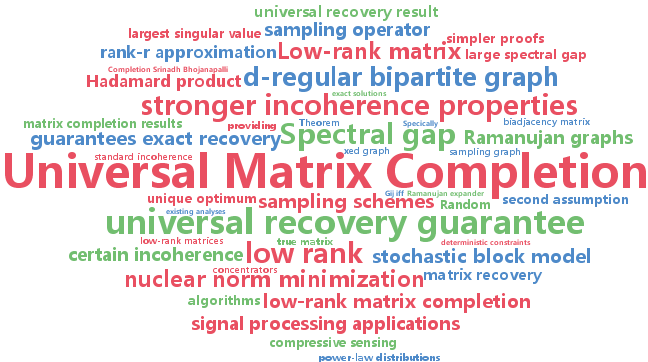algorithms
-
Tian Lin and Bruno Abrahao and Robert Kleinberg and John Lui and Wei Chen
Combinatorial Partial Monitoring Game with Linear Feedback and Its Applications (pdf)
In online learning, a player chooses actions to play and receives reward and feedback from the environment with the goal of maximizing her reward over time. In this paper, we propose the model of combinatorial partial monitoring games with linear feedback, a model which simultaneously addresses limited feedback, infinite outcome space of the environment and exponentially large action space of the player. We present the Global Confidence Bound (GCB) algorithm, which integrates ideas from both combinatorial multi-armed bandits and finite partial monitoring games to handle all the above issues. GCB only requires feedback on a small set of actions and achieves $O(T^{\frac{2
-
Alan Malek and Yasin Abbasi-Yadkori and Peter Bartlett
Linear Programming for Large-Scale Markov Decision Problems (pdf)
We consider the problem of controlling a Markov decision process (MDP) with a large state space, so as to minimize average cost. Since it is intractable to compete with the optimal policy for large scale problems, we pursue the more modest goal of competing with a low-dimensional family of policies. We use the dual linear programming formulation of the MDP average cost problem, in which the variable is a stationary distribution over state-action pairs, and we consider a neighborhood of a low-dimensional subset of the set of stationary distributions (defined in terms of state-action features) as the comparison class. We propose two techniques, one based on stochastic convex optimization, and one based on constraint sampling. In both cases, we give bounds that show that the performance of our algorithms approaches the best achievable by any policy in the comparison class. Most importantly, these results depend on the size of the comparison class, but not on the size of the state space. Preliminary experiments show the effectiveness of the proposed algorithms in a queuing application.
-
Zohar Karnin and Elad Hazan
Hard-Margin Active Linear Regression (pdf)
We consider the fundamental problem of linear regression in which the designer can actively choose observations. This model naturally captures various experiment design settings in medical experiments, ad placement problems and more. Whereas previous literature addresses the soft-margin or mean-square-error variants of the problem, we consider a natural machine learning hard-margin criterion. In this setting, we show that active learning admits significantly better sample complexity bounds than the passive learning counterpart, and give efficient algorithms that attain near-optimal bounds.
-
Safiye Celik and Benjamin Logsdon and Su-In Lee
Efficient Dimensionality Reduction for High-Dimensional Network Estimation (pdf)
We propose module graphical lasso (MGL), an aggressive dimensionality reduction and network estimation technique for a high-dimensional Gaussian graphical model (GGM). MGL achieves scalability, interpretability and robustness by exploiting the modularity property of many real-world networks. Variables are organized into tightly coupled modules and a graph structure is estimated to determine the conditional independencies among modules. MGL iteratively learns the module assignment of variables, the latent variables, each corresponding to a module, and the parameters of the GGM of the latent variables. In synthetic data experiments, MGL outperforms the standard graphical lasso and three other methods that incorporate latent variables into GGMs. When applied to gene expression data from ovarian cancer, MGL outperforms standard clustering algorithms in identifying functionally coherent gene sets and predicting survival time of patients. The learned modules and their dependencies provide novel insights into cancer biology as well as identifying possible novel drug targets.
-
Sungjin Ahn and Babak Shahbaba and Max Welling
Distributed Stochastic Gradient MCMC (pdf)
Probabilistic inference on a big data scale is becoming increasingly relevant to both the machine learning and statistics communities. Here we introduce the first fully distributed MCMC algorithm based on stochastic gradients. We argue that stochastic gradient MCMC algorithms are particularly suited for distributed inference because individual chains can draw minibatches from their local pool of data for a flexible amount of time before jumping to or syncing with other chains. This greatly reduces communication overhead and allows adaptive load balancing. Our experiments for LDA on Wikipedia and Pubmed show that relative to the state of the art in distributed MCMC we reduce compute time from 27 hours to half an hour in order to reach the same perplexity level.
-
Samaneh Azadi and Suvrit Sra
Towards an optimal stochastic alternating direction method of multipliers (pdf)
We study regularized stochastic convex optimization subject to linear equality constraints. This class of problems was recently also studied by Ouyang et al. (2013) and Suzuki (2013); both introduced similar stochastic alternating direction method of multipliers (SADMM) algorithms. However, the analysis of both papers led to suboptimal convergence rates. This paper presents two new SADMM methods: (i) the first attains the minimax optimal rate of O(1/k) for nonsmooth strongly-convex stochastic problems; while (ii) the second progresses towards an optimal rate by exhibiting an O(1/k^2) rate for the smooth part. We present several experiments with our new methods; the results indicate improved performance over competing ADMM methods.
-
Francesco Orabona and Tamir Hazan and Anand Sarwate and Tommi Jaakkola
On Measure Concentration of Random Maximum A-Posteriori Perturbations (pdf)
The maximum a-posteriori (MAP) perturbation framework has emerged as a useful approach for inference and learning in high dimensional complex models. By maximizing a randomly perturbed potential function, MAP perturbations generate unbiased samples from the Gibbs distribution. Unfortunately, the computational cost of generating so many high-dimensional random variables can be prohibitive. More efficient algorithms use sequential sampling strategies based on the expected value of low dimensional MAP perturbations. This paper develops new measure concentration inequalities that bound the number of samples needed to estimate such expected values. Applying the general result to MAP perturbations can yield a more efficient algorithm to approximate sampling from the Gibbs distribution. The measure concentration result is of general interest and may be applicable to other areas involving Monte Carlo estimation of expectations.
-
Stefano Ermon and Carla Gomes and Ashish Sabharwal and Bart Selman
Low-density Parity Constraints for Hashing-Based Discrete Integration (pdf)
In recent years, a number of probabilistic inference and counting techniques have been proposed that exploit pairwise independent hash functions to infer properties of succinctly defined high-dimensional sets. While providing desirable statistical guarantees, typical constructions of such hash functions are themselves not amenable to efficient inference. Inspired by the success of LDPC codes, we propose the use of low-density parity constraints to make inference more tractable in practice. While not strongly universal, we show that such sparse constraints belong to a new class of hash functions that we call Average Universal. These weaker hash functions retain the desirable statistical guarantees needed by most such probabilistic inference methods. Thus, they continue to provide provable accuracy guarantees while at the same time making a number of algorithms significantly more scalable in practice. Using this technique, we provide new, tighter bounds for challenging discrete integration and model counting problems.
-
Richard Combes and Alexandre Proutiere
Unimodal Bandits: Regret Lower Bounds and Optimal Algorithms (pdf)
We consider stochastic multi-armed bandits where the expected reward is a unimodal function over partially ordered arms. This important class of problems has been recently investigated in (Cope 2009, Yu 2011). The set of arms is either discrete, in which case arms correspond to the vertices of a finite graph whose structure represents similarity in rewards, or continuous, in which case arms belong to a bounded interval. For discrete unimodal bandits, we derive asymptotic lower bounds for the regret achieved under any algorithm, and propose OSUB, an algorithm whose regret matches this lower bound. Our algorithm optimally exploits the unimodal structure of the problem, and surprisingly, its asymptotic regret does not depend on the number of arms. We also provide a regret upper bound for OSUB in non-stationary environments where the expected rewards smoothly evolve over time. The analytical results are supported by numerical experiments showing that OSUB performs significantly better than the state-of-the-art algorithms. For continuous sets of arms, we provide a brief discussion. We show that combining an appropriate discretization of the set of arms with the UCB algorithm yields an order-optimal regret, and in practice, outperforms recently proposed algorithms designed to exploit the unimodal structure.
-
Anoop Korattikara and Yutian Chen and Max Welling
Austerity in MCMC Land: Cutting the Metropolis-Hastings Budget (pdf)
Can we make Bayesian posterior MCMC sampling more efficient when faced with very large datasets? We argue that computing the likelihood for N datapoints in the Metropolis-Hastings (MH) test to reach a single binary decision is computationally inefficient. We introduce an approximate MH rule based on a sequential hypothesis test that allows us to accept or reject samples with high confidence using only a fraction of the data required for the exact MH rule. While this method introduces an asymptotic bias, we show that this bias can be controlled and is more than offset by a decrease in variance due to our ability to draw more samples per unit of time.
-
Xin Li and Yuhong Guo
Latent Semantic Representation Learning for Scene Classification (pdf)
The performance of machine learning methods is heavily dependent on the choice of data representation. In real world applications such as scene recognition problems, the widely used low-level input features can fail to explain the high-level semantic label concepts. In this work, we address this problem by proposing a novel patch-based latent variable model to integrate latent contextual representation learning and classification model training in one joint optimization framework. Within this framework, the latent layer of variables bridge the gap between inputs and outputs by providing discriminative explanations for the semantic output labels, while being predictable from the low-level input features. Experiments conducted on standard scene recognition tasks demonstrate the efficacy of the proposed approach, comparing to the state-of-the-art scene recognition methods.
-
Michal Valko and Remi Munos and Branislav Kveton and Tomáš Kocák
Spectral Bandits for Smooth Graph Functions (pdf)
Smooth functions on graphs have wide applications in manifold and semi-supervised learning. In this paper, we study a bandit problem where the payoffs of arms are smooth on a graph. This framework is suitable for solving online learning problems that involve graphs, such as content-based recommendation. In this problem, each item we can recommend is a node and its expected rating is similar to its neighbors. The goal is to recommend items that have high expected ratings. We aim for the algorithms where the cumulative regret with respect to the optimal policy would not scale poorly with the number of nodes. In particular, we introduce the notion of an effective dimension, which is small in real-world graphs, and propose two algorithms for solving our problem that scale linearly and sublinearly in this dimension. Our experiments on real-world content recommendation problem show that a good estimator of user preferences for thousands of items can be learned from just tens of nodes evaluations.
-
Hossein Azari Soufiani and David Parkes and Lirong Xia
Computing Parametric Ranking Models via Rank-Breaking (pdf)
Rank breaking is a methodology introduced by Azari Soufiani et al. (2013a) for applying a Generalized Method of Moments (GMM) algorithm to the estimation of parametric ranking models. Breaking takes full rankings and breaks, or splits them up, into counts for pairs of alternatives that occur in particular positions (e.g., first place and second place, second place and third place). GMMs are of interest because they can achieve significant speed-up relative to maximum likelihood approaches and comparable statistical efficiency. We characterize the breakings for which the estimator is consistent for random utility models (RUMs) including Plackett-Luce and Normal-RUM, develop a general sufficient condition for a full breaking to be the only consistent breaking, and provide a trichotomy theorem in regard to single-edge breakings. Experimental results are presented to show the computational efficiency along with statistical performance of the proposed method.
-
Minmin Chen and Kilian Weinberger and Fei Sha and Yoshua Bengio
Marginalized Denoising Auto-encoders for Nonlinear Representations (pdf)
Denoising auto-encoders (DAEs) have been successfully used to learn new representations for a wide range of machine learning tasks. During training, DAEs make many passes over the training dataset and reconstruct it from partial corruption generated from a pre-specified corrupting distribution. This process learns robust representation, though at the expense of requiring many training epochs, in which the data is explicitly corrupted. In this paper we present the marginalized Denoising Auto-encoder (mDAE), which (approximately) marginalizes out the corruption during training. Effectively, the mDAE takes into account infinitely many corrupted copies of the training data in every epoch, and therefore is able to match or outperform the DAE with much fewer training epochs. We analyze our proposed algorithm and show that it can be understood as a classic auto-encoder with a special form of regularization. In empirical evaluations we show that it attains 1-2 order-of-magnitude speedup in training time over other competing approaches.
-
Ferdinando Cicalese and Eduardo Laber and Aline Medeiros Saettler
Diagnosis determination: decision trees optimizing simultaneously worst and expected testing cost (pdf)
In several applications of automatic diagnosis and active learning a central problem is the evaluation of a discrete function by adaptively querying the values of its variables until the values read uniquely determine the value of the function. In general reading the value of a variable is done at the expense of some cost (computational or possibly a fee to pay the corresponding experiment). The goal is to design a strategy for evaluating the function incurring little cost (in the worst case or in expectation according to a prior distribution on the possible variables' assignments). We provide an algorithm that builds a strategy (decision tree) with both expected cost and worst cost which are at most an $O(\log n)$ factor away from, respectively, the minimum possible expected cost and the minimum possible worst cost. Our algorithm provides the best possible approximation simultaneously with respect to both criteria. In fact, there is no algorithm that can guarantee $o(\log n)$ approximation, under the assumption that ${\cal P
-
Elad Eban and Elad Mezuman and Amir Globerson
Discrete Chebyshev Classifiers (pdf)
In large scale learning problems it is often easy to collect simple statistics of the data, but hard or impractical to store all the original data. A key question in this setting is how to construct classifiers based on such partial information. One traditional approach to the problem has been to use maximum entropy arguments to induce a complete distribution on variables from statistics. However, this approach essentially makes conditional independence assumptions about the distribution, and furthermore does not optimize prediction loss. Here we present a framework for discriminative learning given a set of statistics. Specifically, we address the case where all variables are discrete and we have access to various marginals. Our approach minimizes the worst case hinge loss in this case, which upper bounds the generalization error. We show that for certain sets of statistics the problem is tractable, and in the general case can be approximated using MAP LP relaxations. Empirical results show that the method is competitive with other approaches that use the same input.
-
Anoop Cherian
Nearest Neighbors Using Compact Sparse Codes (pdf)
In this paper, we propose a novel scheme for approximate nearest neighbor (ANN) retrieval based on dictionary learning and sparse coding. Our key innovation is to build compact codes, dubbed SpANN codes, using the active set of sparse coded data. These codes are then used to index an inverted file table for fast retrieval. The active sets are often found to be sensitive to small differences among data points, resulting in only near duplicate retrieval. We show that this sensitivity is related to the coherence of the dictionary; small coherence resulting in better retrieval. To this end, we propose a novel dictionary learning formulation with incoherence constraints and an efficient method to solve it. Experiments are conducted on two state-of-the-art computer vision datasets with 1M data points and show an order of magnitude improvement in retrieval accuracy without sacrificing memory and query time compared to the state-of-the-art methods.
-
Gunnar Carlsson and Facundo Mémoli and Alejandro Ribeiro and Santiago Segarra
Hierarchical Quasi-Clustering Methods for Asymmetric Networks (pdf)
This paper introduces hierarchical quasi-clustering methods, a generalization of hierarchical clustering for asymmetric networks where the output structure preserves the asymmetry of the input data. We show that this output structure is equivalent to a finite quasi-ultrametric space and study admissibility with respect to two desirable properties. We prove that a modified version of single linkage is the only admissible quasi-clustering method. Moreover, we show stability of the proposed method and we establish invariance properties fulfilled by it. Algorithms are further developed and the value of quasi-clustering analysis is illustrated with a study of internal migration within United States.
-
Stanislav Minsker and Sanvesh Srivastava and Lizhen Lin and David Dunson
Scalable and Robust Bayesian Inference via the Median Posterior (pdf)
Many Bayesian learning methods for massive data benefit from working with small subsets of observations. In particular, significant progress has been made in scalable Bayesian learning via stochastic approximation. However, Bayesian learning methods in distributed computing environments are often problem- or distribution-specific and use ad hoc techniques. We propose a novel general approach to Bayesian inference that is scalable and robust to corruption in the data. Our technique is based on the idea of splitting the data into several non-overlapping subgroups, evaluating the posterior distribution given each independent subgroup, and then combining the results. The main novelty is the proposed aggregation step which is based on finding the geometric median of posterior distributions. We present both theoretical and numerical results illustrating the advantages of our approach.
-
Harm van Seijen and Rich Sutton
True Online TD(lambda) (pdf)
TD(lambda) is a core algorithm of modern reinforcement learning. Its appeal comes from its equivalence to a clear and conceptually simple forward view, and the fact that it can be implemented online in an inexpensive manner. However, the equivalence between TD(lambda) and the forward view is exact only for the off-line version of the algorithm (in which updates are made only at the end of each episode). In the online version of TD(lambda) (in which updates are made at each step, which generally performs better and is always used in applications) the match to the forward view is only approximate. In a sense this is unavoidable for the conventional forward view, as it itself presumes that the estimates are unchanging during an episode. In this paper we introduce a new forward view that takes into account the possibility of changing estimates and a new variant of TD(lambda) that exactly achieves it. Our algorithm uses a new form of eligibility trace similar to but different from conventional accumulating and replacing traces. The overall computational complexity is the same as TD(lambda), even when using function approximation. In our empirical comparisons, our algorithm outperformed TD(lambda) in all of its variations. It seems, by adhering more truly to the original goal of TD(lambda)---matching an intuitively clear forward view even in the online case---that we have found a new algorithm that simply improves on classical TD(lambda).
-
Yevgeny Seldin and Aleksandrs Slivkins
One Practical Algorithm for Both Stochastic and Adversarial Bandits (pdf)
We present an algorithm for multiarmed bandits that achieves almost optimal performance in both stochastic and adversarial regimes without prior knowledge about the nature of the environment. Our algorithm is based on augmentation of the EXP3 algorithm with a new control lever in the form of exploration parameters that are tailored individually for each arm. The algorithm simultaneously applies the ``old'' control lever, the learning rate, to control the regret in the adversarial regime and the new control lever to detect and exploit gaps between the arm losses. This secures problem-dependent ``logarithmic'' regret when gaps are present without compromising on the worst-case performance guarantee in the adversarial regime. We show that the algorithm can exploit both the usual expected gaps between the arm losses in the stochastic regime and deterministic gaps between the arm losses in the adversarial regime. The algorithm retains ``logarithmic'' regret guarantee in the stochastic regime even when some observations are contaminated by an adversary, as long as on average the contamination does not reduce the gap by more than a half. Our results for the stochastic regime are supported by experimental validation.
-
Srinadh Bhojanapalli and Prateek Jain
Universal Matrix Completion (pdf)
The problem of low-rank matrix completion has recently generated a lot of interest leading to several results that offer exact solutions to the problem. However, in order to do so, these methods make assumptions that can be quite restrictive in practice. More specifically, the methods assume that: a) the observed indices are sampled uniformly at random, and b) for every new matrix, the observed indices are sampled \emph{afresh
-
Hongyu Su and Aristides Gionis and Juho Rousu
Structured Prediction of Network Response (pdf)
We introduce the following network response problem: given a complex network and an action, predict the subnetwork that responds to action, that is, which nodes perform the action and which directed edges relay the action to the adjacent nodes. We approach the problem through max-margin structured learning, in which a compatibility score is learned between the actions and their activated subnetworks. Thus, unlike the most popular influence network approaches, our method, called SPIN, is context-sensitive, namely, the presence, the direction and the dynamics of influences depend on the properties of the actions. The inference problems of finding the highest scoring as well as the worst margin violating networks, are proven to be NP-hard. To solve the problems, we present an approximate inference method through a semi-definite programming relaxation (SDP), as well as a more scalable greedy heuristic algorithm. In our experiments, we demonstrate that taking advantage of the context given by the actions and the network structure leads SPIN to a markedly better predictive performance over competing methods.



